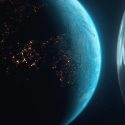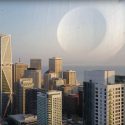What causes moonquakes? What would happen if half of our Moon drifted away? Has the Moon already split in half?
As friendly neighbors in the sky, the Moon and Earth have a symbiotic relationship. The Moon’s gravity keeps us on a fixed schedule, creating tides that travel around the Earth every 24 hours.
Since the Moon is tidally locked to the Earth, we always see the same side of the Moon. So if we lost the dark side, we might not notice it immediately. But would the other half start to drift away?
If the two halves can escape each other’s gravity over millions and possibly billions of years, the Moon chunks would become spherical again, sculpted over time by gravity. The Earth could be left with two smaller Moons, making Star Wars fans everywhere rejoice.
Even if the Moon were cut in half, we would only notice a difference if one piece disappeared. If the Moon were half its size, we’d experience only partial solar eclipses, known as annular eclipses.
With less mass, the Moon would start to venture closer to Earth. So even though it would be smaller in size, it might look bigger to us. And with weaker Moon gravity, our tides would be smaller, affecting underwater ecosystems living in the intertidal zone, the area between high and low tide.
Sea turtles, seabirds, and fish would be endangered. Knowing when to feed, lay eggs or migrate would be incredibly difficult without the regularity of the tides. The presence of the Moon also slows down the Earth’s rotation. This keeps our days 24 hours long. With only half a Moon, there would be less drag on Earth, leading to 15 hour days. If you’re working the night shift, I’m sorry, but prepare for a pay cut.
With less stability from the Moon’s gravity, the Earth’s axial tilt would change, causing dramatic seasonal shifts and swings in temperature. This is why Mars has such crazy weather. Its two tiny moons make Mars wobble on its axis, causing dramatic changes in temperature and high winds.
So how exactly could the Moon split in half? Well, like Earth, the Moon has several active faults called thrust faults. Over millions of years, the Moon has cooled down from a hot melted rock to what we have today. This cooling has caused the Moon to shrink in a process known as thermal contraction. The Moon has gotten about 50 m (150 ft) skinnier over the last several hundred million years.
As the Moon shrinks, its volume decreases and compresses the surface. Like a grape turning into a raisin, the Moon wrinkles as it shrinks, causing its crust to shift and trigger intense moonquakes. Some of them are quite strong, around five on the Richter scale.
A moonquake would have to be pretty severe to cut the Moon in half. But an asteroid impact in the right spot could do the trick. Although, it wouldn’t be a clean cut and would likely shatter the Moon into several pieces.
Some historians surmise that the Moon may have cracked in the past. On June 18, 1178, several people in Southern England reported seeing a raging fire spread like a snake on the Moon. Astronomers think that what these villagers saw could have been the 3 km (1.8 mi) asteroid that formed Giordano Bruno’s crater. This would have triggered the expulsion of a massive amount of lunar material, about 10 million tons (20 billion lb) in the direction of Earth. Talk about an epic meteor shower!
While the Moon likely won’t split in half anytime soon, it is moving away from us at a speed of 3.78 cm (1.5 in) per year. That may not seem like much, but with many potential Moon mining projects in the works, our Moon could look very different in the future. So I guess, enjoy it while it lasts.
Sources
- “Layers Of The Moon – Different Layers And Structure Of The Moon”. Rocheleau, Jake. 2012. Planet Facts.
- “The Moon’s Surface Is Totally Cracked | Live Science”. Mindy, Wesiberger. 2021. livescience.com.
- “What Is Diameter Of The Moon? – Universe Today”. 2008. Universe Today.
- “The moon is still geologically active, study suggests”. David, Rothery. 2021. phys.org.
- “Shrinking Moon May Be Generating Moonquakes”. 2021. NASA.
- “The Mystery Of The Moon That Was Split In Two | Openmind”. 2018. Openmind.
- “How does the Moon affect the Earth?”. 2021. How Does The Moon Affect The Earth? | Institute Of Physics.
- “Earth’s Stabilizing Moon May Be Unique Within Universe”. 2021. space.com.



























